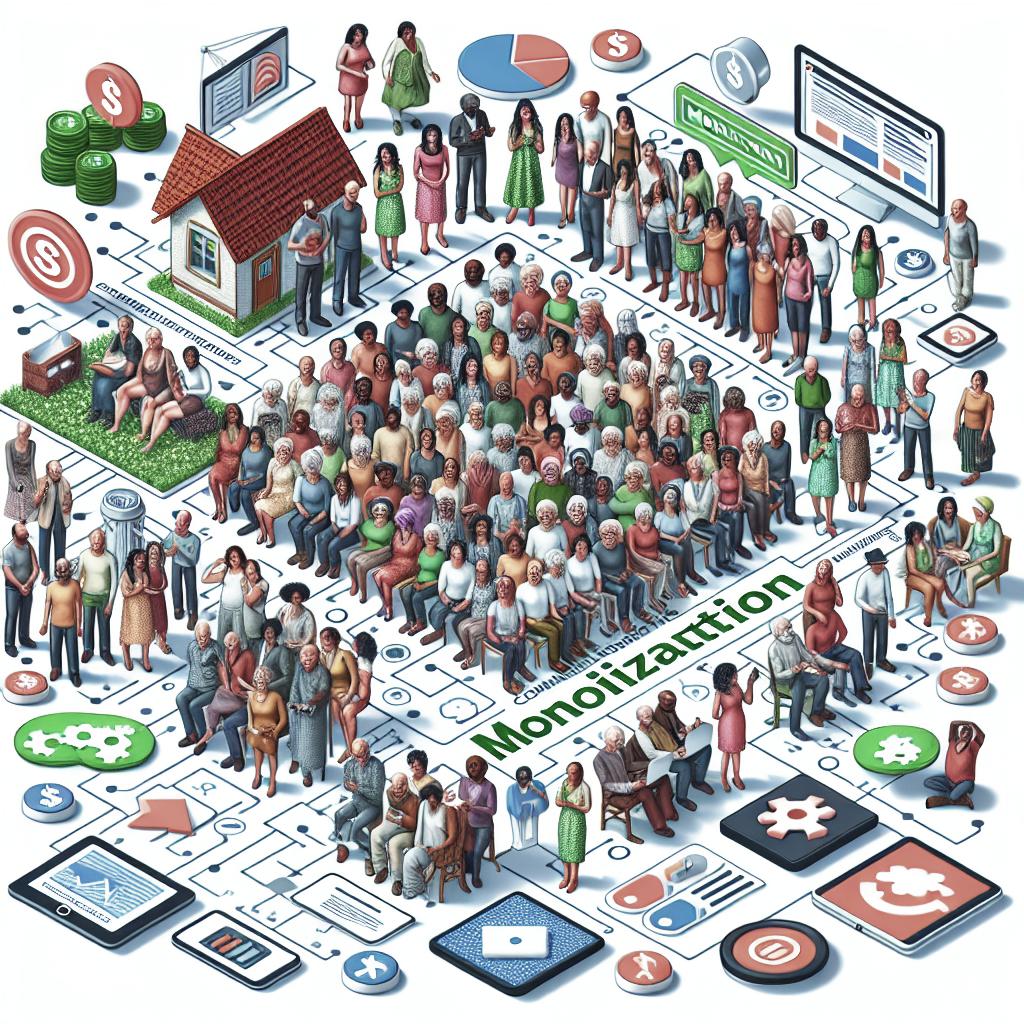Monetizing a Community: Strategies and Best Practices
Building a vibrant community is no small feat, and for many creators and leaders, turning their passionate community into a sustainable source of income is a natural next step. In this blog post, we delve into the reasons why monetizing a community can be beneficial and explore various strategies that can be employed to achieve this goal. Whether through paid memberships, collaboration with brands, or selling digital products, the opportunities are as diverse as the communities themselves. Additionally, we provide best practices for ethical and successful monetization, ensuring that community engagement and satisfaction remain at the forefront. Finally, we summarize key points in a convenient table for easy reference.
Contents
- Why should you monetize your community?
-
How to monetize a community
- Paid community space
- Coaching and mentorship
- Brand partnerships
- Donations or pay-what-you-can
- Courses and workshops
- Event tickets
- Merchandise or swag
- Digital products
-
Best practices for monetizing a community
- Know your worth
- Experiment with your pricing model
- Understand your audience
- Put community first
- Ready to take your community to the next level?
Why should you monetize your community?
Monetizing a community can bring a variety of benefits to community leaders and members alike. For starters, generating income can allow creators to reinvest in the infrastructure, tools, and services that improve the community experience. Whether it’s through more frequent events or better technology, these investments can lead to higher member satisfaction and retention.
Furthermore, monetization can often be an indicator of the community’s success and authenticity. When members are willing to pay for access or contribute in other monetary ways, it signifies the value they see in the community. Moreover, a monetized community can sustain itself over the long term, avoiding pitfalls like burnout or dwindling resources that often affect volunteer-led groups.
How to monetize a community
1. Paid community space
Implementing a subscription model or charging a fee for exclusive access can be a straightforward way to monetize a community. Platforms like Patreon, Discord, or even private Facebook or Slack groups offer ample opportunity for setting up a paid community space. The key is to provide value that justifies the cost, such as exclusive content, personalized interaction, or insider perks.
However, transparency is crucial when using this model. Clearly communicating what paying members will receive helps in setting expectations and building trust. Regular assessments of the value provided versus the fees charged can also help in retaining members.
2. Coaching and mentorship
Leverage your expertise to offer one-on-one or group coaching sessions. Many community members may seek personalized advice and guidance, especially in niche communities focused on professional or personal development. Tailoring sessions to address specific needs can significantly increase the perceived value.
Pricing for coaching or mentorship can vary widely depending on the industry and experience level, but always ensure that your rates reflect the value you’re offering. Testimonials and case studies can also bolster your credentials and serve as powerful marketing tools.
3. Brand partnerships
Collaborating with brands that align with your community’s values and interests can provide a steady income stream. Such partnerships can range from affiliate marketing and sponsored posts to co-branded products and events. The key is to maintain authenticity and only work with brands that resonate with your community.
Transparency is paramount in brand partnerships; clearly disclose sponsorships to maintain trust. Additionally, ensure that any collaboration genuinely adds value to your community rather than simply appearing as a cash grab.
4. Donations or pay-what-you-can
Setting up a donation system or a pay-what-you-can model can engage your community’s generosity while keeping access relatively open. Platforms like Ko-fi or Buy Me a Coffee make it easy to integrate a donation system with minimal setup.
This model works particularly well for communities that have fostered strong loyalty and goodwill. Be sure to express gratitude and possibly offer small incentives or acknowledgments for donors to encourage continued support.
5. Courses and workshops
Offering educational courses or interactive workshops can monetize your community while providing substantial value. With platforms like Teachable or Thinkific, you can create comprehensive courses with video lessons, assignments, and quizzes.
When creating courses, ensure that the content is relevant and meets the skill levels of your community members. Pre-launch surveys can help determine the most in-demand topics, ensuring a successful course rollout.
6. Event tickets
Organizing events, whether virtual or in person, can create monetization opportunities through ticket sales. These events could include conferences, webinars, or exclusive meet-ups with high-profile speakers.
Successful events often require thoughtful planning and marketing to attract attendees. Partnering with industry experts or influencers can amplify outreach efforts, drawing in larger audiences and maximizing revenue potential.
7. Merchandise or swag
Creating and selling community-specific merchandise is a tangible way to engage and monetize your audience. Merchandise could range from branded clothing and accessories to custom stickers or home goods, serving as a great way to build brand identity and loyalty.
Merchandise design should resonate with the community’s culture and values. Limited edition items or seasonal releases can create excitement and drive sales, provided there is a clear demand.
8. Digital products
Digital products, such as ebooks, templates, or software tools, offer high-margin opportunities for community monetization. These products can provide practical solutions or entertainment, often with relatively low production costs.
Successful digital products should deliver clear value and be of high quality. Pre-launch promotions and early access offerings can create buzz and ensure that your digital products meet initial sales goals.
Best practices for monetizing a community
1. Know your worth
Understanding the intrinsic value of your community and what it offers is crucial. Set competitive and fair pricing that reflects the time, effort, and expertise you provide. A well-researched pricing strategy will ensure you are compensated fairly while also attracting buyers.
Regularly reviewing industry trends and competitor pricing can offer insights into market standards, helping you to adjust pricing as necessary without undervaluing your contributions.
2. Experiment with your pricing model
There is no one-size-fits-all approach when it comes to pricing. Experimenting with different models, such as tiered membership or bundle offers, can help you discover what works best for your community.
Be open to feedback and customer input, as these can provide valuable insights for refining pricing strategies. Piloting new pricing structures can also identify which approaches are most effective and well-received.
3. Understand your audience
Deep insights into your community’s demographics, motivations, and pain points can inform monetization strategies that truly resonate. Collecting data through surveys, polls, and direct conversations can help you tailor offerings to meet member needs.
Once you have a solid understanding of your audience, focus your efforts on creating value propositions that address their specific challenges or interests, fostering deep engagement and loyalty.
4. Put community first
While monetization is important, the core aim should be the enrichment and well-being of the community. Prioritize relationships and trust, ensuring that any monetization efforts do not detract from the community’s essence or core mission.
Open communication, transparency about how funds are used, and consistent member feedback can help maintain a balance between monetization objectives and community goals.
Ready to take your community to the next level?
Monetizing a community is an exciting journey that can unlock numerous opportunities for growth and sustainability. By choosing the right monetization strategies and focusing on best practices, you can create a thriving community that generates income and delivers exceptional value to its members.
Community leaders who continue to innovate and adapt to the ever-changing digital landscape will not only achieve financial success but also enhance the member experience, ensuring long-term engagement and loyalty.
| Monetization Strategy | Description |
|---|---|
| Paid community space | Offer exclusive access and content for subscriptions or membership fees. |
| Coaching and mentorship | Provide personalized guidance and expertise to community members. |
| Brand partnerships | Collaborate with brands for sponsorships that align with your values. |
| Donations or pay-what-you-can | Utilize community generosity through donation systems or flexible pricing. |
| Courses and workshops | Run educational sessions offering valuable skills and knowledge. |
| Event tickets | Host events with ticket sales for webinars, conferences, or meet-ups. |
| Merchandise or swag | Sell branded items to create community identity and loyalty. |
| Digital products | Offer ebooks, templates, or tools with high ROI potential. |


